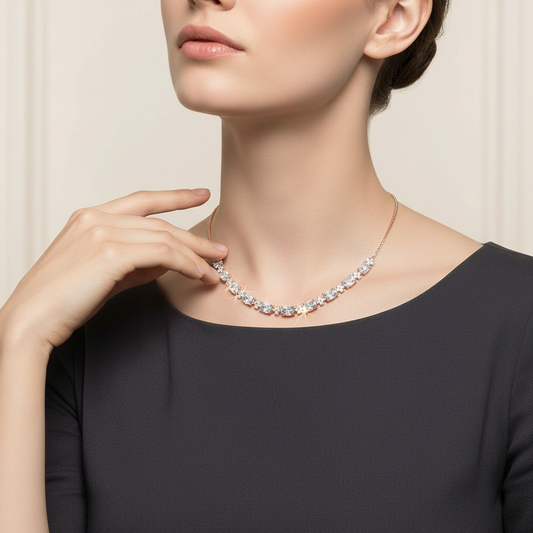Women’s Engagement Diamond Ring Maintenance: How to Care for Yours Long-Term

A diamond engagement ring isn’t just a piece of jewellery- it’s a symbol of love and commitment meant to last for decades. To ensure it continues shining as brilliantly as your intentions behind it, a perfect care routine is essential. Below is a detailed guide to long-term maintenance of your diamond engagement ring: how to treat it daily, clean it safely, protect it from damage, and preserve its value.
1. Understanding your ring: what you’re caring for
Your ring contains two main parts: the diamond (or other gemstone) and the metal setting (gold, platinum, white gold, etc.). Though diamonds are extremely hard, they are not unbreakable- they can chip, scratch neighbouring facets, or become loose if the setting is compromised.
Meanwhile, the metal band and setting are exposed to everyday wear, cleaning agents, lotions and more; over time these can dull the finish, scratch the metal or weaken the structure.
Recognizing that both the stone and its setting deserve care helps you set the right mindset: this is not just “wipe it and forget it”, but a continuous relationship.
Looking for a ring that's built to last? Explore our women's engagement diamond ring collection to find beautifully crafted pieces designed with durability and elegance in mind.
2. Daily habits for long-term care
Small actions, repeated consistently, have a big impact when caring for your engagement ring.
- Remove it during certain activities. When you’re doing heavy lifting, working out, cleaning with chemicals, or heading to the beach or pool, it’s wise thing to take your ring off. These activities includes risk: sand or grit can scratch the setting; chlorine or salt water can erode metal; sudden knocks can chip the stone.
- Be mindful when applying lotions, perfumes or sunscreen. Many of these products carry oils or chemical residues that build up on the stone or setting and diminish shine over time. For example, one expert warns that sunscreen residue can dull the band.
- Use a relevant “ring dish” or safe spot at home. When you remove the ring (to wash hands, cook, or shower), placing it consistently in a dish prevents accidental loss or scratching with other jewelry.
- Avoid sleeping with your ring on (if possible). While many wear it to bed, sleeping can cause friction between your ring and bedding or hair, which may gradually wear the setting or loosen stones.
These habits don’t require your heavy effort- but they add up to protect your ring from cumulative damage.
3. Safe cleaning: at-home techniques
Cleaning your ring periodically helps maintain its brilliance and allows you to spot potential issues early.
- How often: At-home cleaning should be done around once a week (or at least every few weeks) for frequent wear.
- Method: Use a bowl of warm (not hot) water with a few drops of mild dish soap. Soak the ring for 10-30 minutes. Then use a soft-bristled toothbrush to gently clean beneath the stone and around the prongs. Rinse thoroughly (make sure the drain is blocked!) and dry with a lint-free cloth.
- What to avoid: Harsh chemicals (bleach, chlorine, acetone) and abrasive cleaners (such as toothpaste or baking soda) should be avoided—they may scratch the metal or damage the setting over time.
- Ultrasonic cleaners: While tempting, at-home ultrasonic machines are not always safe for engagement rings, especially those with delicate settings or smaller pavé stones- they may loosen stones.
By cleaning gently and regularly you keep your ring looking sharp- and you also maintain visibility of the setting so you can spot any wobble or intrusion of grime.
Want more diamond pieces to cherish and care for? Browse our women's diamond ring collection for stunning designs perfect for every occasion and built to be treasured for years.
4. Professional maintenance & inspection
Even with perfect daily care and regular at-home cleaning, professional check-ups are vital.
- Inspection frequency: Many jewellers recommend having your ring inspected (and cleaned) once or twice per year. During this check, the prongs, setting and stone integrity are examined.
- What the jeweller does: They’ll look for loose stones, uneven prongs, thinning metal, potential re-plating (in white gold settings), and they may provide a deeper clean or polish. Polishing should be done sparingly because it gradually removes metal layers.
- Budget for maintenance: While many stores offer complimentary cleanings at purchase, make sure you ask about manufacturer or store policies for inspection and repair down the road.
- Insurance and valuation: Because engagement rings often carry significant value- both sentimental and monetary- it is a good thing to ensure they are insured.
This layer of professional care ensures that little issues haven’t slipped past your at-home routine.
5. Storage and long-term precautions
When your engagement ring isn’t on your finger, how you store it matters.
- Store separately: Diamonds can scratch other jewellery (and be scratched), so keep your ring in a soft pouch or a dedicated compartment rather than piled in a jewellery box.
- Avoid extreme conditions: Heat, chemicals, and prolonged exposure to pools/spas can degrade the metal or setting. One guide advises to avoid hot tubs and cold water shrinkage risks.
- Traveling: When you travel, especially to beach or pool destinations, remove your ring and store it in a secure, discreet location. Fluctuating finger size, sand, salt water and sunscreen residue all elevate the risk of damage or loss.
These storage prevents idle hours from becoming damage-hours.
6. Knowing when to take your ring off
There are specific situations where removing your ring is not just advisable but necessary also.
- Physical work or intense activity: Heavy lifting, sports, gardening- all expose your ring to knocks, bending, and abrasion.
- Water immersion / beach / pool: Cold water may shrink your finger temporarily; sand and salt water can rub against the metal and setting.
- Applying lotions, cream, or working with chemicals: These can cause film or abrasive effects on the metal and setting.
- When you sleep (optional): If your ring catches bedding, hair or moves repeatedly, it may over time loosen prongs. Removing it overnight (and storing it wisely) reduces that risk.
Being strategic about when you wear and when you remove your ring helps prevent avoidable damage.
Looking to expand your jewelry collection with pieces as timeless as your engagement ring? Discover our women's gold and diamond jewelry collection for exquisite designs that deserve the same loving care.
7. Summary & final thoughts
Your engagement ring is more than a beautiful accessory- it’s a piece designed to tell your story over years, even generations. The care it demands is not arduous: a thoughtful habit here, a gentle cleaning there, periodic professional check-ups, and wise storage. Together these will ensure your ring keeps reflecting your commitment as brightly as it did the day you first slipped it on.
By cleaning regularly, protecting it from harm, and inspecting it professionally, you safeguard both its beauty and its integrity. Over time, that care becomes part of the ring’s legacy. And when you take it off at the end of a busy day, placing it in its dish with confidence, you’re doing more than preserving a jewel- you’re honouring something precious.








